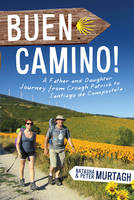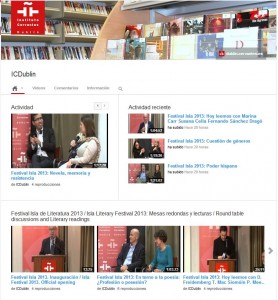Blog del Instituto Cervantes de Dublín
Torre Martello
The Way of Saint James / El Camino de Santiago

Nuestro tema del mes es el Camino de Santiago, una de las principales rutas culturales europeas. Cada año miles de peregrinos procedentes de toda España y Europa recorren un largo trecho para llegar a la ciudad de Santiago de Compostela, donde se veneran las reliquias del apóstol Santiago el Mayor. La creencia cada vez más extendida en los milagros de Santiago, provocó que la gente comenzara a peregrinar hacia Santiago de Compostela para obtener su gracia.
El Camino de Santiago significó el primer elemento vertebrador del viejo continente en la historia europea y supuso encontrar un punto de referencia indiscutible en el que podía converger la pluralidad de distintos pueblos ya cristianizados pero necesitados en aquel entonces de unidad.
Ha estado unido indisociablemente a la cultura, a la formación y a la información. Lo que se decía, predicaba, contaba, cantaba, esculpía o pintaba en el camino alcanzaba siempre a más gente y a más lugares. Gracias a su influjo en el arte y la literatura, Compostela junto con Jerusalén y Roma se convirtió en meta de la sociedad cristiana, especialmente a partir del siglo XI al XIV. El camino llegaría a ser un foco catalizador de toda la sociedad cristiana.
Durante toda la Edad Media fue muy popular, después fue ligeramente olvidado debido a diversos factores (la peste, la reforma protestante y los conflictos políticos). En la época actual ha vuelto a tomar un gran auge. El Camino de Santiago Francés y las rutas francesas del Camino fueron declarados por la Unesco Patrimonio de la Humanidad en 1993 y 1998 respectivamente, Itinerario Cultural Europeo por el Consejo de Europa y ha recibido el título honorífico de Calle mayor de Europa. En el Año Santo Compostelano de 1993, el gobierno autónomo gallego decidió potenciar su valor enfocado a un recurso turístico, de este modo se lanzó una gran campaña de publicidad para el Jacobeo de ese año: Xacobeo 93. Gracias a este plan se restauraron tramos de la ruta y las infraestructuras para peregrinos.
Desde entonces, hacer el recorrido a pie, en bicicleta o a caballo e incluso en burro es un destino popular que reúne lo religioso, espiritual, deportivo, cultural, económico, etc., tal y como ha venido ocurriendo desde el principio a través de los siglos. El camino se halla indicado por flechas pintadas de amarillo, postes y otras señales. La mayoría de los peregrinos llega a Santiago por el llamado “Camino Francés”, pero existen otras seis rutas históricas por las cuales se puede hacer el camino santo.
Si quieres preparar tu viaje de peregrinación a Santiago o simplemente saber más sobre el Camino, en la biblioteca tenemos una amplia selección de obras que te pueden ayudar.
Our topic of the month is the Camino de Santiago (The Way of St James), one of the most important European cultural routes. Every year thousands of pilgrims coming from all parts of Spain and Europe go a long distance until arriving to Santiago de Compostela where the remains of the apostle Saint James are venerated. It started when people started to believe in St James’ miracles and therefore they started to do the pilgrimage to Santiago to get his grace.
Camino de Santiago was the first backbone of the old continent in the European history and an indisputable reference point where the different conceptions of Christian peoples could find a common unity.
It has been linked inherently to culture, education and information. Everything that was said, preached, told, sung, sculpted or painted in the Camino got to a large number of people and places. Thanks to its influence in art and literature, Compostela along with Jerusalem and Rome became a meeting point of Christian society, especially between the 11th and 14th century.
It was highly travelled during the Middle ages but several factors (the Black Death, the Protestant Reformation and political unrest) led to its decline. By the 1980s, only a few pilgrims per year arrived in Santiago. Later, the route attracted a growing number of modern-day pilgrims from around the globe. The route was declared the first European Cultural Route by the Council of Europe in October 1987; it was also named one of UNESCO’s World Heritage Sites in 1993.
In 1993, a Jubilee Year, the Galician government decided to increase its popularity and planned a big advertising campaign to promote the Camino and the infrastructures were highly improved.
Today tens of thousands of Christian pilgrims and many other travellers set out each year from their front doorstep, or popular starting points across Europe, to make their way to Santiago de Compostela. Most travel by foot, some by bicycle, and a few travel as some of their medieval counterparts did, on horseback or by donkey.
In addition to people undertaking a religious pilgrimage, the majority are travellers and hikers who walk the route for non-religious reasons: travel, sport, or simply the challenge of weeks of walking in a foreign land. Also, many consider the experience a spiritual adventure to remove themselves from the bustle of modern life. It serves as a retreat for many modern “pilgrims”.
Most of the pilgrims arrive to Santiago by taking the French Way but there are other six historical routes to do the Camino.
If you want to prepare your pilgrimage route to Santiago or simply to know more about the Camino, in the library we have an ample selection of works that can help you.
Entradas relacionadas
Etiquetas
Biblioteca Dámaso Alonso Biblioteca Instituto Cervantes Camino de Santiago La biblioteca sugiere Spanish Library in Dublin St. James Way The library suggests Travel to Spain



